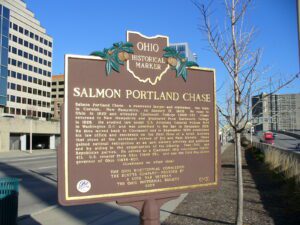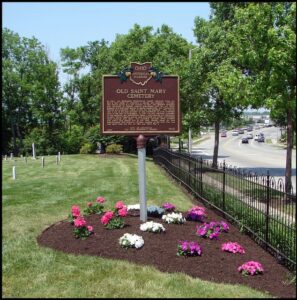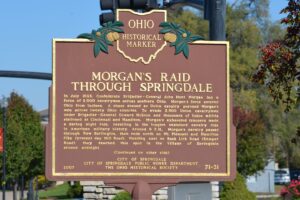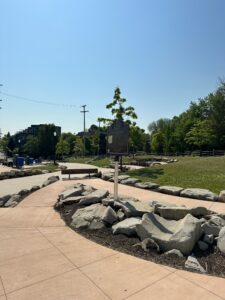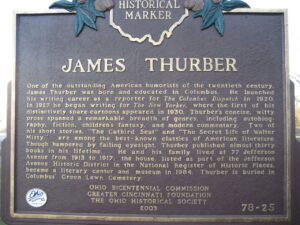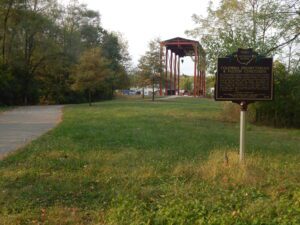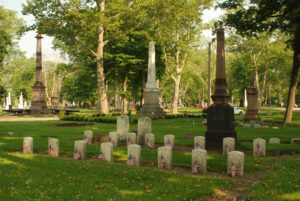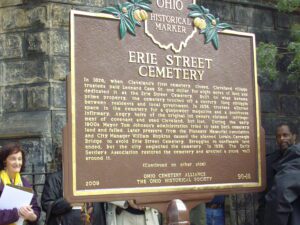, OH
Salmon Portland Chase, a renowned lawyer and statesman, was born in Cornish, New Hampshire, on January 13, 1808. He came to Ohio in 1820 and attended Cincinnati College (1822-23). Chase returned to New Hampshire and graduated from Dartmouth College in 1826. He studied law under U.S. Attorney General William Wirt in Washington D.C. and was admitted to the bar in December 1829. He then moved back to Cincinnati and in September 1830 established his law office and residence on the first floor of a brick building that stood at the northeast corner of 3rd and Main Streets. Chase gained national recognition as an anti-slavery attorney and politician and by aiding in the organization of the Liberty, Free-Soil, and Republican parties. He served as a Cincinnati city councilman (1840-41), U.S. senator from Ohio (1849-55), and was the first Republican governor of Ohio (1856-60). (continued on other side)
, OH
In 1801, the Springdale Presbyterian Church acquired these two and a half acres to construct a church and cemetery. Although the church moved to a new location in 1833, the cemetery remained and continued to receive regular internments until the mid 1950s. Because of a continued decline in church membership, the Presbyterian Church was eventually unable to care for the cemetery. The church felt it was in the best interest of the community to turn ownership over to the City of Springdale. In 1987, the city received ownership of the cemetery and immediately began a maintenance and restoration project. Many forgotten graves were uncovered and broken gravestones were restored and reset. The cemetery contains seven hundred and thirty nine graves and is the final resting place for nine Revolutionary War veterans, thirteen veterans of the Civil War, and one each from the War of 1812 and World War I.
, OH
In July 1863, Confederate Brigadier-General John Hunt Morgan led a force of 2,000 cavalrymen across southern Ohio. Morgan’s force entered Ohio from Indiana. A chase ensued as Union cavalry pursued Morgan’s men across twenty Ohio counties. To evade 2,500 Union cavalrymen under Brigadier-General Edward Hobson and thousands of Union militia stationed at Cincinnati and Hamilton, Morgan’s exhausted troopers made a daring night ride, resulting in the longest sustained cavalry ride in American military history. Around 9 P.M., Morgan’s cavalry passed through New Burlington, then rode north on Mt. Pleasant and Hamilton Pike (present day Mill Road). Heading east on Bank Lick Road (Kemper Road), they reached this spot in the Village of Springdale around midnight. (Continued on other side)
, OH
Opened in July 1862, the 35 1/2-acre site here in Brooklyn Township’s University Heights served as the largest Civil War army camp of rendezvous, organization, and training in northeast Ohio. It was bordered by Hershel (now West 5th) and University (now West 7th) streets and Railway and Marquard avenues. A wartime high of 4,151 volunteers occupied the barracks here on December 5, 1862. Lieutenant William Dustin of the 19th Ohio Volunteer Artillery wrote, “It was a table land above the city and admirably suited to the use of a camp of instruction. It was as level as a floor and carpeted with grass. The capacious pine barracks held about 25 each of the battery’s men.” A total of 15,230 men trained here during the war–4.9 percent of the 310,646 enlistments in Ohio. More than 11,000 soldiers were discharged here at war’s end. It closed in August 1865. (continued on other side)
, OH
One of the outstanding American humorists of the twentieth century, James Thurber was born and educated in Columbus. He launched his writing career as a reporter for The Columbus Dispatch in 1920. In 1927 he began writing for The New Yorker, where the first of his distinctively spare cartoons appeared in 1930. Thurber’s concise, witty prose spanned a remarkable breadth of genres, including autobiography, fiction, children’s fantasy, and modern commentary. Two of his short stories, “The Catbird Seat” and “The Secret Life of Walter Mitty,” are among the best-known classics of American literature. Though hampered by failing eyesight, Thurber published almost thirty books in his lifetime. He and his family lived at 77 Jefferson Avenue from 1913 to 1917; the house, listed as part of the Jefferson Avenue Historic District in the National Register of Historic Places, became a literary center and museum in 1984. Thurber is buried in Columbus’ Green Lawn Cemetery.
, OH
The cemetery dates to 1794 and is comprised of two adjacent cemeteries: Columbia Presbyterian Cemetery and Fulton Cemetery. Another cemetery, the Fulton Mechanics Cemetery, had been in Fulton, a village along the Ohio River and a center of boat-building and steamboat construction during the first half of 19th century. Together, the cemeteries are the burial places of Jacob Allen, John Campbell, John Langdon, and other veterans of the Revolutionary War. It is also believed that William Brown is buried here. Brown was one of three soldiers during the Revolutionary War to receive the Badge of Military Merit, predecessor of the Purple Heart. The cemetery was listed on the National Register of Historic Places in 1979. (Continued on other side)
, OH
Howard Daniels, who lived from 1815-1863, was a noted architect and landscape gardener. Over the course of his life, he designed six Ohio and New York cemeteries, including Woodland that began in 1852 when he laid out 20 of its 60 acres into fashionable “rural cemetery” style. Later acreage in the cemetery adapted his curvilinear design. “As beautifully prepared for a burial place as fancy and taste could desire,” Woodland was dedicated on June 14, 1853, and became Cleveland’s primary cemetery. An ornate gatehouse, chapel, and fountains came later. Generations of Clevelanders, pioneering and prominent, as well as veterans onward from the War of 1812, are buried here. For more than a century, Woodland, in its original and newly platted sections, has embraced people from every race, the rich and poor, natives and immigrants, and the famous and obscure. It has truly become a community cemetery. [continued on other side]
, OH
In 1826, when Cleveland’s first cemetery closed, Cleveland village trustees paid Leonard Case Sr. one dollar for eight acres of land and dedicated it as the Erie Street Cemetery. Built on what became prime property, the cemetery touched off a century long struggle between residents and local government. In 1836, trustees allotted space in the cemetery for a gunpowder magazine and a poorhouse infirmary. Angry heirs of the original lot owners claimed infringement of covenant and sued Cleveland, but lost. During the early 1900s Mayor Tom Johnson’s administration tried to take back cemetery land and failed. Later pressure from the Pioneers’ Memorial Association and City Manager William Hopkins caused the planned Lorain Carnegie Bridge to avoid Erie Street Cemetery. Struggles to confiscate land ended, but the city neglected the cemetery. In 1939, The Early Settler’s Association restored the cemetery and erected a stone wall around it. (continued on other side)


